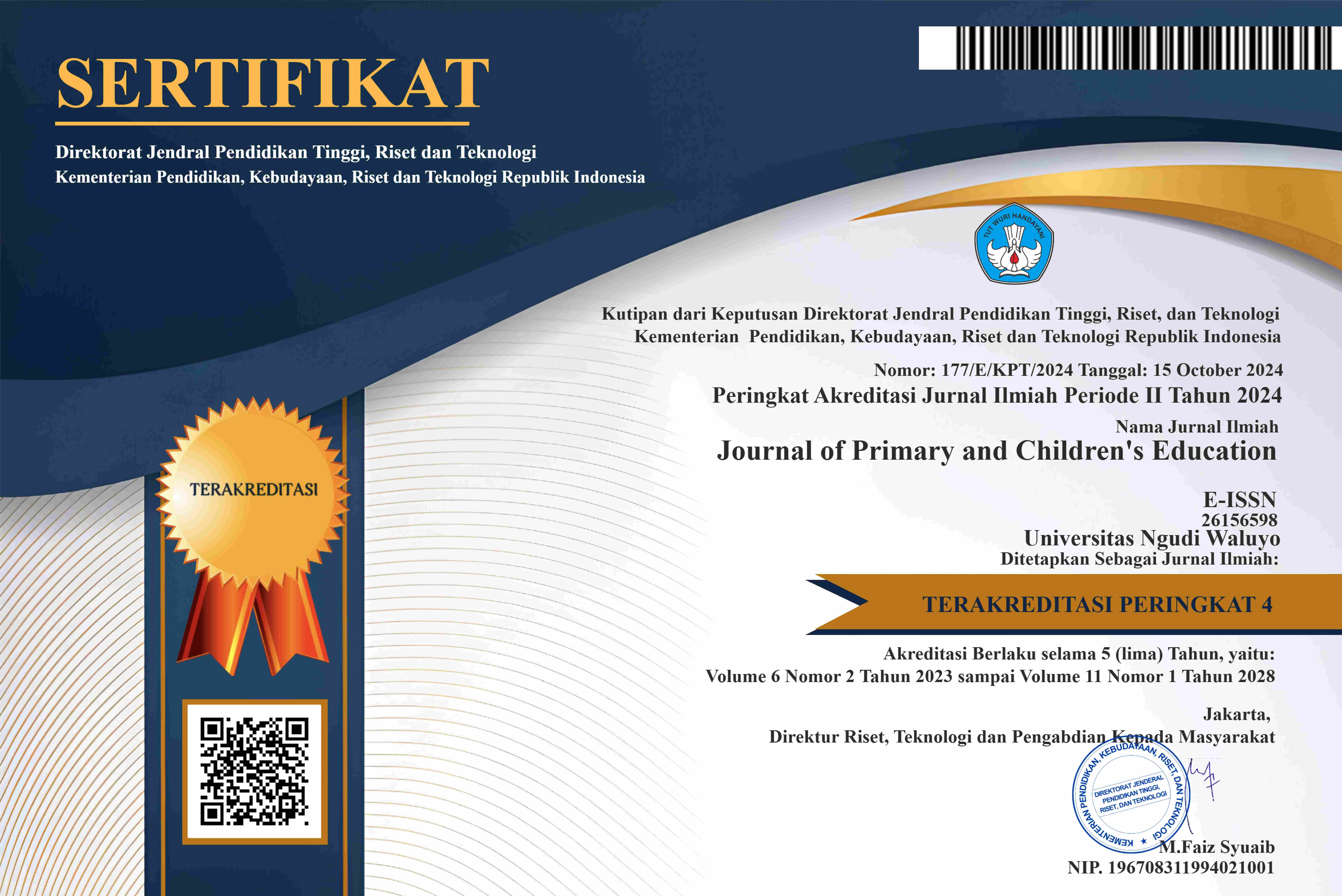Keefektifan Model Jigsaw Dan STAD Terhadap Pencapaian Karakter Dan Kemampuan Numerasi Siswa Kelas V SD
DOI:
https://doi.org/10.35473/jnctt.v6i1.2262Keywords:
Model Jigsaw, STAD, dan NumersiAbstract
In the learning process in class V SDN Karanggeneng 02, the students' character achievement and students' numeracy skills were still low. This condition was improved through the use of innovative learning models. The researcher aimed to determine the effectiveness of the Jigsaw and STAD learning models on the character and numeracy achievement of fifth grade students. This research is an experimental research with a learning observation research design and pretest posttest. The samples in this study were the VA class using the Jigsaw learning model and the VB class using the STAD learning model. The data obtained from the results of the research were analyzed using a statistical test, then the t-test results were carried out. From the results of the analysis and tests, this study showed a significant difference in effectiveness. In the Jigsaw model, the level of effectiveness is 77.02%, while in the STAD model it is 48.32%. So that it can be stated that the Jigsaw learning model is more effective in achieving the character and numeracy abilities of fifth grade elementary school students.
Dalam proses pembelajaran di kelas V SDN Karanggeneng 02 pencapaian karakter siswa dan kemampuan numerasi siswa masih rendah.Kondisi tersebut diperbaiki melalui penggunaan model pembelajaran yang inovatif.Peneliti bertujuan mengetahui keefektifan model pembelajaran Jigsaw dan STAD terhadap pencapaian karakter dan numerasi siswa kelas V . Penelitian ini merupakan penelitian eksperimen dengan desain penelitian observasi pembelajaran dan pretes posttes.Sempel dalam penelitian ini adalah kelas VA menggunakan model pembelajaran Jigsaw dan kelas VB menggunakan model pembelajaran STAD. Perolehan data dari hasil penelitian dianalisis menggunakan Uji statistic,selanjutnya dilakukan Uji-t hasil. Dari hasil analisis dan uji tersebut penelitian ini menunjukkan tingkat perbedaan keefektifan yang signifikan. Pada model Jigsaw tingkat keefektifannya 77,02% sedangkan model STAD 48,32%. Sehingga dapat dinyatakan model pembelajaran Jigsaw lebih efektif terhadap pencapaian karakter dan kemampuan numerasi siswa kelas V SD.
References
Afandi, M., & Irawan, D. (2013). Pembelajaran Kooperatif Tipe Student Teams Achievement Division di Sekoah Dasar. In Unissula Press.
Aisyah, Siti. (2021). Model Jigsaw Berbantu Kartu Soal Meningkatkan Aktivitas Dan Hasil Belajar Matematika Siswa Kelas VI. Jannacitta: Journal of Primary and Children’s Education, 4 (1), 30-41.
Ariani, Tri. (2018). Model Pembelajaran Student Team Achievement Division (STAD) Dan Model Pembelajaran Teams Games Tournament (TGT): Dampak Terhadap Hasil Belajar Fisika. SPEJ: Science and Physics Education Journal, Vol. 1 (2), 65-77.
Efendi, Irfan. (2022). Analisis Literasi Numerasi Dalam Menyelesaikan Soal High Order Thinking Skill (Hots) Pada Siswa Kelas VIII SMP Negeri 2 Barombong. Skripsi. Universitas Muhammadiyah Makassar
Fitria, S. W., Tisngati, U., Muhammadin, A., & Fath, A. (2021). Analisis Kesulitan Belajar Matematika SD Ditinjau Dari Kemampuan Literasi Numerasi Pada Siswa Kelas IV Di SD Negeri Ngadirejan. 1–12.
Harleni, S. (2020). Efektivitas Model Pembelajaran Kooperatif Tipe Jigsaw Terhadap Hasil Belajar Aljabar Linear Dengan Memamfaatkan Matlab. Jurnal Education and Development, 3.
Kemendikbud. (2018). Permendikbud RI No 20 Tahun 2018. Tentang Penguatan Pendidikan Karakter Pada Satuan Pendidikan Formal, 8–12.
Nurhayati. (2020). Peningkatan Hasil Belajar Siswa Dengan Menggunakan Model Pembelajaran Kooperatif Tipe Jigsaw Dalam Pembelajaran Ipa Kelas 3 Semester 2 SD Negeri Gogodalem 01 Kecamatan Bringin Kabupaten Semarang Tahun Ajaran 2018/ 2019. Jannacitta: Journal of Primary and Children’s Education, 3 (1), 57-65.
Pangesti, F. T. P. (2018). Menumbuhkembangkan literasi numerasi pada pembelajaran matematika dengan soal HOTS. Indonesian Digital Journal of Mathematics and Education, 5(9), 566-575.
Rahman, A. A. & H. M. (2015). Perbandingan Kemampuan Pemahaman Konsep Matematika Siswa Menggunakan Model Pembelajaran Kooperatif Tipe Student Teams Achievement Division (STAD) Dengan Team Game Tournament (TGT) Di SD Islam Khalifah. Jurnal Bina Gogik, 2(1), 38–48.
Santika, I Wayan Eka. (2020). Pendidikan Karakter pada Pembelajaran Daring. IVCEJ, Vol 3 (1), 8-19.
Shoimin, A. (2014). Model Pembelajaran Inovatif Dalam Kurikulum 2013. Maguwoharjo: AR-RUZZ Media.
Sugianto, Armanto, D., & Harahap, M. B. (2014). Perbedaan Penerapan Model Pembelajaran Kooperatif Tipe Jigsaw dan Komunikasi Matematis Siswa SMA. Jurnal Didaktik Matematika, 1(1), 96–128.
Sugiyono. (2015). Metode Penelitian Kuantitatif, Kualitatif dan R&D. Bandung: Alfabeta.
Susanto, A. (2014). Pengembang Pembelajaran IPS di Sekolah Dasar. Jakarta: Prenadamedia Group.
Wulandari, Innayah. (2022) Model Pembelajaran Kooperatif Tipe STAD (Student Teams Achievement Division) dalam Pembelajaran MI. Jurnal Papeda, Vol 4 (1), 17-23.
Yunianto, T., Suyadi, S., & Suherman, S. (2020). Pembelajaran abad 21: Pengaruhnya terhadap pembentukan karakter akhlak melalui pembelajaran STAD dan PBL dalam kurikulum 2013. Premiere Educandum : Jurnal Pendidikan Dasar Dan Pembelajaran, 10(2), 203.
Downloads
Published
How to Cite
Issue
Section
License
Copyright notice:
- Authors retain copyright and grant the journal right of first publication with the work simultaneously licensed under Creative Commons Attribution License that allows others to share the work with an acknowledgement of the work's authorship and initial publication in this journal.
- Authors are able to enter into separate, additional contractual arrangements for the non-exclusive distribution of the journal's published version of the work (e.g., post it to an institutional repository or publish it in a book), with an acknowledgement of its initial publication in this journal.
- Authors are permitted and encouraged to post their work online (e.g., in institutional repositories or on their website) prior to and during the submission process, as it can lead to productive exchanges, as well as earlier and greater citation of published work (The Effect of Open Access)







